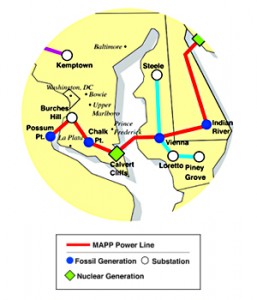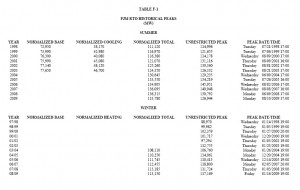MID-Atlantic Power Pathway and all of PJM’s “backbone” projects in the news:

She’s worried about a larger line rising in the shadow of her house. If the poles somehow get knocked over, “Where’s that line going to fall? That line’s going to fall in my living room.
That’s Farah Morelli’s question. She’s a regular person who woke up one day with a monstrously large transmission line planned literally in her back yard. That’s usually the most effective way to get someone to learn about transmission. It’s a steep learning curve, and what I’ve found in my work with people in the path of proposed transmission is that once they start looking, they find a disturbing fact: Utilities propose transmission lines not because they’re “needed” but that they’re wanted, wanted to increase their ability to transmit and SELL cheap power in areas where it’s higher cost, and make a bundle in the process. It’s not that people don’t have electricity (and high price is the best instigator of conservation), but it’s that people want more and want it cheaper and the utilities which make $$$ from that equation want to make it happen.
HERE’S THE REALITY — The PJM 2010 Load Forecast Report and the Monitoring Analytics “PJM 3Q State of the Market” report show that this market decline isn’t anything new and that it’s not going away anytime soon. The PJM market peaked in 2006:

Today’s News Journal article is a start at pulling it all together, taking a look at the bigger picture, and that bigger picture is what these transmission lines are all about. Three lines were proposed together, the Potomac Allegheny Transmission Highline (PATH), the Mid-Atlantic Power Pathway (MAPP) and the Susquehanna-Roseland line. These aren’t just transmission lines, they’re BIG HONKIN’ ELECTRICAL AUTOBAHNS, quad (or now maybe tri?) bundled 500kV lines. Like WOW. HUGE!
Here’s today’s article:
Economy, increased efficiency, carbon consciousness delay projects
By AARON NATHANS • The News Journal • January 24, 2010
It was Delaware’s electric doomsday scenario: Living room lights would go dark unless Delmarva Power could import electricity to a growing population.
Just a few years back, power companies lined up to design hulking new lines to bring power from the Midwest, where 56 percent of electricity is generated by coal-burning plants.
Those plans included building a high-voltage line from Virginia to New Jersey that would have unfurled across the heart of Delaware, helping assure reliable power to the state — and costing customers of Delmarva Power $1.2 billion.
But the world changed — seemingly overnight.
Now regional power grid operator PJM Interconnection is dialing back its projections of future energy use amid a sluggish economy, increases in energy efficiency and the new economics of energy in the age of carbon consciousness.
That has set off a domino reaction of delays in power companies’ plans to build those lines, as PJM reassesses when the lines will be needed, if they’re needed at all.
The reassessment is a chance to wean the country off fossil fuels and build the infrastructure around locally sited renewables without having to erect giant electrified structures in peoples’ backyards, said Carol Overland, an attorney representing opponents of a proposed large power line in New Jersey.
“It’s a very good shift. Culturally, that’s a shift we need to make,” Overland said. “It gives us an opportunity to do it differently.”
Although Delmarva has rights of way through most of its planned Delaware route, it is working to acquire the rights to build on long stretches of land on Maryland’s Eastern Shore, through farms like the one owned by Libby Nagel, of Vienna. Portions of the farm have been in her family for 100 years. She has been fighting the line, saying it will interrupt irrigation and get in the way of low-flying pesticide spray planes. She is concerned Delmarva will invoke eminent domain to force the line onto her property.
“This transmission line is about them bringing cheap coal-fired power in here,” Nagel said, arguing it’s more about profits than reliability. “They say we’re going to benefit. But it is a transmission line. That’s all it is.”
The line, known as the Mid-Atlantic Power Pathway, was proposed in 2006 by Delmarva Power’s parent company, Pepco Holdings, Inc. It would run from Virginia to Maryland, across the Chesapeake Bay and end at the Indian River Power Plant in Millsboro.
The line originally was to continue on to the nuclear power plant in Salem, N.J., but that leg was pushed back last summer after PJM ran computer models and found that reliability issues in Delaware have eased due to a downturn in electricity usage.
Last month, those models showed a wider shift, which led PJM to tell two power companies that portions of its Potomac-Appalachian Transmission Highline would not be needed in 2014 as scheduled. The “PATH” project, sponsored by Allegheny Energy and American Electric Power, would link West Virginia to the Frederick, Md. area.
Read the rest of this entry »

